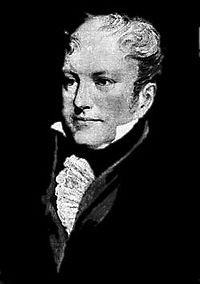- Charles Stirling
-
Charles Stirling 
Vice-Admiral Charles StirlingBorn 28 April 1760
LondonDied 7 November 1833 (aged 73)
Woburn Farm, Chertsey, SurreyAllegiance  United Kingdom of
United Kingdom of
Great Britain and IrelandService/branch  Royal Navy
Royal NavyRank Vice-Admiral Commands held
Commander-in-Chief, Jamaica
HMS Pompée
Commissioner Jamaica Dockyard
HMS Glory
HMS Sampson
HMS Diadem
Commander-in-Chief, Cape of Good HopeBattles/wars - French Revolutionary War
- Napoleonic War
- War of 1812
Awards Freedom of the City of London Sir Charles Stirling (28 April 1760 – 7 November 1833) was a vice-admiral in the Royal Navy.
Contents
Early life and career
Charles Stirling was born in London on 28 April 1760 and baptised at St. Albans on 15 May. The son of Admiral Sir Walter Stirling, he was born into a family with a long and proud naval tradition. Stirling joined the Royal Navy and was promoted to Captain in 1783. On 11 August 1789 he married Charlotte Grote at Greenwich, London. He was involved in the famous battle of the Glorious First of June in 1794, and took part in the July 1801 Battle of Algeciras as captain of the 74-gun HMS Pompée. Later that year he was appointed Commissioner at Jamaica Yard.
Admiral
Stirling was recalled to England in late 1804, and on arrival was promoted to Rear Admiral and given command of the 98-gun HMS Glory, which had been one of the famous ships involved in the Glorious First of June battle, and was now the flagship of the Rochefort squadron. Stirling immediately arranged for his nephew James to transfer to his ship as a midshipman. James Stirling would remain under his uncle's command until 1808, and would be enormously influenced by his uncle, both professionally and personally.
On 22 July 1805, Stirling took part in the Battle of Cape Finisterre under Sir Robert Calder, during which his squadron attacked the combined French and Spanish fleets off Cape Finisterre. In July 1806 he was given command of the ship HMS Sampson and order to convoy General Samuel Auchmuty's troops to Buenos Aires, where he would relieve Admiral Sir Home Riggs Popham, who, with troops under William Carr Beresford, had captured Buenos Aires in the first of a series of British invasions of the Río de la Plata. By the time he arrived, Buenos Aires had been retaken by the Spanish, so after relieving Popham and transferring to Popham's ship, the HMS Diadem, Stirling aided Auchmuty in a successful attack on Montevideo. He was later praised in both Houses of Parliament and in the British press for his good judgement.
Shortly after the capture of Montevideo, Stirling was relieved and ordered to take up the office of Naval Commander-in-Chief at the Cape of Good Hope. He was recalled to London after about 5 months. On 31 July 1810, he was promoted to Vice Admiral, and given the Freedom of the City of London. He also received a sword with "gallant and meritorious conduct at the capture of the Fortress of Monte Video" inscribed on the hilt. Stirling took an extended period of leave, but in October 1811 returned to active service to take up an appointment as Commander-in-Chief of the squadron at Jamaica. When war broke out with America, he was placed under the command of Admiral Sir John Borlase Warren in September 1812, and led his squadron in harassing American shipping and conducting coastal raids in the Bermuda area.
Court martial
In June 1813 Stirling was relieved and ordered to return to London. On arriving in London late in 1813, he learned that he had been recalled to face charges of accepting payment for protecting foreign seamen. The specific charges were contained in a letter written by Commissioner Wolley at Jamaica, who claimed "that His Majesty's Naval Service had been brought into disrepute in consequence of it being spoken of publicly that ships of war were hired out to convoy vessels going to the Spanish Main." Wolley cited a specific incident, when Stirling was said to have received $2000 for the hire of His Majesty's sloop HMS Sappho. Aspects of the charge were dismissed, but the verdict that was handed down in May 1814 was "that the charge had been in part proved." Although it was agreed that Stirling's actions were excusable on humanitarian grounds, he had acted against regulations. He was retired on half pay, and barred from further promotion.
Stirling appealed in July and won a number of concessions: a restoration to Flag Officer status and the right to continue to be addressed as Senior Vice Admiral of the White. The admiralty, however, refused to return him to active service.
Later life
Stirling's wife died on 25 March 1825 at Woburn Farm, Chertsey, Surrey. Stirling was reported as seriously ill in September 1833, and he died at Woburn Farm on 7 November 1833.
Cultural references
Charles Stirling appears as a character in the book Master and Commander by Patrick O'Brian.
References
- Statham-Drew, Pamela (2003). James Stirling: Admiral and Founding Governor of Western Australia. Nedlands, Western Australia: University of Western Australia Press. ISBN 1-876268-94-8.
Further reading
The following sources were not consulted in the writing of this article:
- Stirling, T. W. (1933). The Stirlings of Cadder: An account of the Original Family of that Name and of The Family of the STIRLINGS OF DRUMPELLIER With which the Representation of the Ancient House of Cadder now lies. St Andrews University Press.
Categories:- 1760 births
- 1833 deaths
- Royal Navy admirals
- British naval personnel of the Napoleonic Wars
Wikimedia Foundation. 2010.
